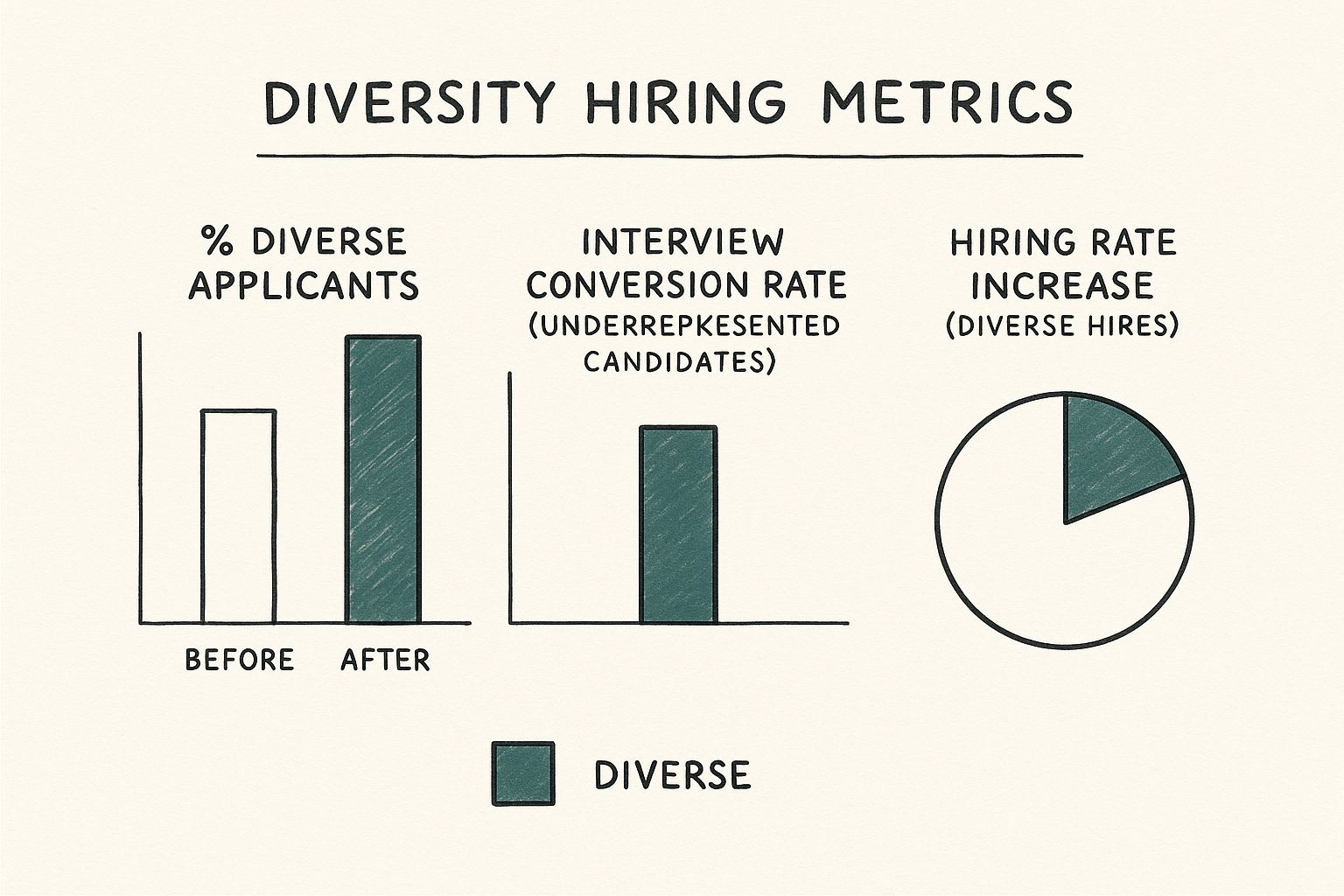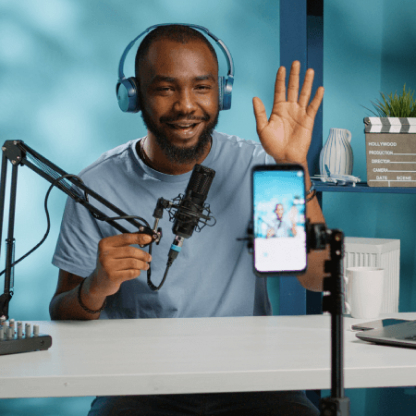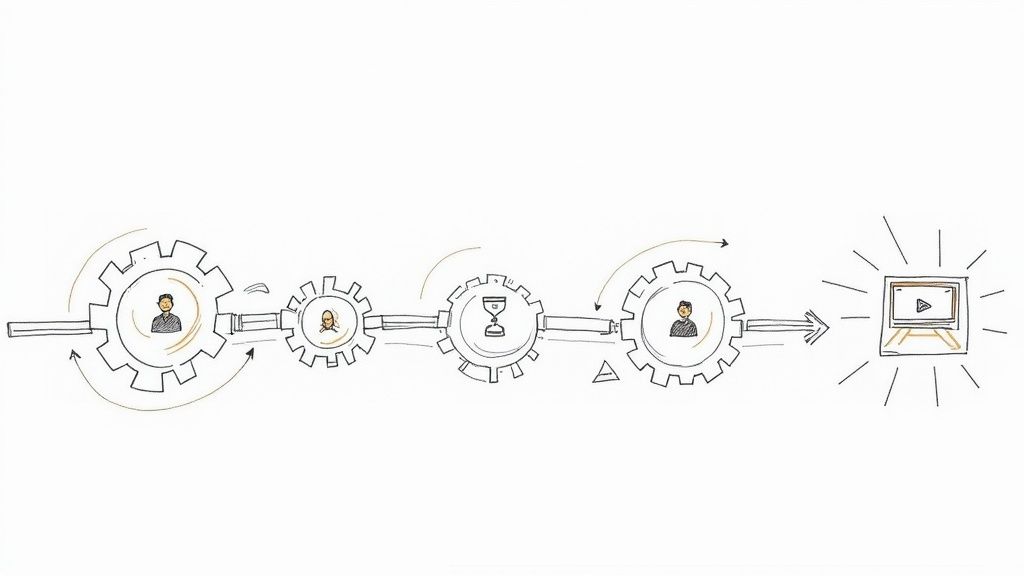Let’s get one thing straight: authentic diversity and inclusion in recruitment isn’t about hitting quotas or plastering stock photos on your careers page. It’s about building a resilient, innovative company that actually reflects the real world—and gaining a massive competitive advantage while you’re at it.
Turns out there’s more than one way to hire elite talent without mortgaging your office ping-pong table.
Moving Past Performative DEI in Recruitment

We’ve all seen the empty mission statements. For years, "D&I" was treated like a PR problem to be managed, not a core business strategy to be executed. Companies spent more time crafting the perfect diversity statement than they did fixing the broken hiring processes that created homogenous teams in the first place.
But the tide is turning, and fast. The conversation around diversity and inclusion has finally moved from the HR department to the boardroom. Leaders are waking up to the fact that this isn't just about "doing the right thing."
It's about survival.
The Wake-Up Call for Modern Companies
Globally, the commitment to DEI has skyrocketed. According to the World Economic Forum, 83% of employers now have DEI initiatives in place. In North America, that figure is an astonishing 96%. This isn't a fleeting trend; it’s a fundamental shift in how smart companies build their teams. You can see all the data in the full global DEI adoption report from the World Economic Forum.
So, why the sudden urgency? Because the cost of inaction is brutal. Homogenous teams are prone to groupthink, they’re slower to innovate, and they’re far less adaptable to market changes. They are, in a word, fragile.
The painful truth is that "culture fit" is often just code for hiring people exactly like you—a one-way ticket to stagnation. It feels safe, but it’s the most dangerous decision a founder can make.
From Window Dressing to Winning Strategy
It's easy to talk a big game on D&I. Real change, however, means getting uncomfortably honest about what's not working. It’s about tearing down the old systems that favor familiarity over actual merit.
So many companies fall into the trap of performative gestures—actions that look good on the surface but don't move the needle. The real magic happens with strategic, intentional actions.
Here’s a look at the difference:
Performative Gesture vs. Strategic Action
| The Performative Gesture (What Most Companies Do) | The Strategic Action (What Actually Works) |
|---|---|
| Writing a generic "we value diversity" statement. | Auditing job descriptions for exclusionary language and biased requirements. |
| Posting a celebratory social media graphic once a year. | Building long-term partnerships with diverse professional organizations and communities. |
| Relying on "culture fit" to make hiring decisions. | Training hiring managers to screen for "culture add" and what new perspectives a candidate brings. |
| Asking for diverse referrals without changing the process. | Implementing structured interviews and standardized scorecards to remove gut-feel bias. |
| Setting diversity quotas without accountability. | Tying leadership bonuses and performance reviews to measurable D&I outcomes. |
The first column is easy. It's PR. The second column is hard work. It's strategy.
Moving beyond performative DEI means making a conscious choice to do the hard work. It’s about fundamentally rewiring how you find, assess, and hire talent. The companies that get this right will dominate the next decade. Those that don’t? They’ll be left wondering where all the great candidates went.
Why Your Best Candidates Are Walking Away
Ever had that sinking feeling when an A-player, someone with a resume that seemed tailor-made for the role, just… ghosts you? It happens all the time. Here’s a little secret: they were sizing up your commitment to diversity and inclusion long before you ever hopped on a call.
Today’s top talent can smell a token effort from a mile away. They aren’t just looking for another job; they’re looking for a company that genuinely mirrors their own values. Your employer brand isn't what you splash across your careers page—it's what candidates actually experience.
And for many of them, that experience is a swift "thanks, but no thanks."
The Silent Deal-Breaker in Your Hiring Funnel
The new wave of talent doesn't just stumble upon jobs; they actively vet companies on their DEI credentials. A job description loaded with bro-y jargon, an interview panel that looks like a carbon copy of itself, or a vague, non-committal diversity statement all send a crystal-clear signal.
That signal? You’re either not serious about building an inclusive culture or, even worse, you’re completely clueless. Neither one is a good look.
And this isn't just about losing out on "diverse" candidates. It's about losing the best candidates, full stop. High performers want to be part of winning teams, and they know that a homogenous environment is a fast track to stagnation. They crave colleagues who challenge their thinking, not just echo it.
Your lackluster DEI strategy isn't just a blind spot; it's a gaping hole in your talent pipeline. While you’re wondering why you can’t close top candidates, they’ve already moved on to a competitor who gets it.
The Numbers Don't Lie
This isn't just a gut feeling; it’s a massive shift in candidate behavior backed by hard data. The research paints a pretty stark picture for companies that are slow to adapt.
A staggering 67% of job seekers across the globe say workplace diversity is a make-or-break factor when they consider job offers. That number shoots through the roof for Millennials and Gen Z, who happen to be the most diverse generations in history. Over on LinkedIn, 77% of talent professionals now see DEI as an essential part of their hiring strategy, simply because they know it’s a non-negotiable for the people they want to hire. You can discover more about how DEI impacts hiring decisions in recent studies.
So, what does this all mean for you? It means that for every ten candidates you engage, at least six are actively scoring your commitment to diversity and inclusion in recruitment. If your process feels biased or exclusionary, they're already gone before you even get a chance to make your pitch. This is your wake-up call.
Confronting Unconscious Bias in Your Hiring Funnel
Let’s get something straight: everyone thinks they’re objective. And almost everyone is wrong. Unconscious bias is the silent killer of diversity and inclusion in recruitment, and pretending it doesn’t exist is like hoping a ship will steer itself through a storm. Good luck with that.
This is where we get uncomfortably real. These biases aren't abstract HR concepts; they are concrete, gut-level decisions that sabotage your hiring goals every single day. We're talking about the subtle, insidious shortcuts our brains take that lead us to hire the same type of person over and over again.
It's time to stop trusting your gut and start trusting a process. Your intuition is great for picking a lunch spot, but it’s a terrible tool for building a world-class team. It’s riddled with biases you don’t even know you have.
The Usual Suspects of Hiring Bias
These biases creep into every single stage of the funnel, from the first resume glance to the final handshake. They’re the reason your pipeline might look diverse at the top but becomes strangely homogenous by the time you're ready to make an offer.
Here are a few of the most common culprits:
- Affinity Bias: This is the "mini-me" effect. You just click with a candidate because they went to your alma mater, share your love for obscure 90s indie rock, or just remind you of yourself. It feels like great chemistry, but it’s actually a bias that filters out anyone who isn’t a carbon copy of you.
- Halo Effect: The candidate worked at Google or has an Ivy League degree, so you automatically assume everything they say is brilliant. This one impressive data point creates a "halo" that can blind you to potential weaknesses or a glaring lack of relevant, practical skills.
- Confirmation Bias: You form an initial impression—good or bad—within the first five minutes. Then, you spend the rest of the interview subconsciously looking for evidence to confirm that first hunch. You end up asking leading questions and interpreting their answers in a way that proves you were right all along.
The infographic below really drives this home, showing how intentional changes, like crafting more inclusive job descriptions, can directly combat these biases and make a real difference in your hiring metrics.

As the data shows, it's the systemic changes—not just good intentions—that move the needle on attracting, converting, and hiring underrepresented talent.
Fighting this takes more than a one-off training session that everyone clicks through while checking their email. It's about building systems that force fairness into a process that is inherently human and, therefore, flawed.
To start, you need to implement robust fair hiring practices. Another powerful strategy is structuring your process to remove identifying information early on. For a closer look at how technology can help create a more level playing field from the get-go, check out our guide on automated candidate screening.
Sourcing Talent Beyond the Usual Suspects

If you keep fishing in the same pond, you’re going to keep catching the same fish. It’s that simple. Relying on the same old job boards and waiting for employee referrals to roll in is a surefire recipe for a homogenous workforce. The talent is out there, but you have to be intentional about where you look.
Let’s be honest: just posting your job on a few so-called "diverse" job boards is lazy. It’s a box-ticking exercise that rarely moves the needle. Building a truly diverse talent pipeline requires proactive, deliberate effort. It means you have to get out of the office—virtually or physically—and build actual relationships.
This isn't about some feel-good initiative; it's about strategic pipeline building. If your sourcing strategy hasn't changed in five years, don't expect the makeup of your team to change, either.
Ditch the Jargon and Expand Your Reach
Before you even think about where to find candidates, take a hard look at what you're posting. Is your job description littered with alienating jargon like "rockstar," "ninja," or "code wizard"? Research shows that "masculine-coded" words like "driven" and "competitive" can actively discourage women from even applying.
Strip it all out. Focus on what the person will actually do and the core skills needed to succeed. Keep the requirements to the absolute essentials, and you’ll immediately widen your applicant pool without lowering your standards one bit.
Once your job description is clean, it's time to think beyond LinkedIn.
- Build Real Partnerships: Don't just email the career center at a Historically Black College or University (HBCU) once a year. Sponsor a senior project, host a workshop, or offer to mentor students. The same goes for professional organizations for underrepresented groups in your industry—show up and get involved.
- Explore Untapped Talent Pools: Think about return-to-work programs for parents who took a career break. Or what about apprenticeships for skilled individuals who don't have a traditional four-year degree? These are goldmines of loyal, experienced talent that your competitors are completely ignoring.
- Connect with Communities: To broaden your search beyond conventional methods, consider leveraging business networking groups. These communities offer direct access to professionals from a wide range of backgrounds you might not otherwise reach.
Sourcing for diversity isn't a one-time campaign; it's a continuous, relationship-driven function. It requires patience and a genuine investment of time, but the payoff is a talent pipeline that becomes a massive competitive advantage.
For those ready to overhaul their entire approach, we’ve put together a deeper dive into modern candidate sourcing strategies that go far beyond the basics.
The bottom line is this: stop waiting for diverse candidates to find you. You need to go find them.
Building an Inclusive Culture from Day One

So you did it. You revamped your sourcing, neutralized your job descriptions, and hired a wonderfully diverse team. Pop the champagne, right? Not so fast. The hardest part has just begun.
Hiring for diversity without building an inclusive culture is like meticulously planning a party and then forgetting to buy any food or drinks. Your guests will show up, realize there’s nothing for them, and leave. You can't just invite people to the party; you have to ask them to dance.
This is precisely where most companies drop the ball. They pour all their energy into recruitment and treat retention as an afterthought. It's an expensive, soul-crushing mistake that turns your company into a revolving door for top talent.
Beyond the Standard Welcome Wagon
True inclusion starts the second an offer is signed. It's about making sure every new hire feels like they belong, not just like they’re being tolerated. This means looking beyond the obvious and auditing the entire employee journey, especially for groups that are too often overlooked.
It’s no longer enough to just focus on gender and ethnicity. We need to be having serious conversations about accessibility and neurodiversity. For instance, while over a billion people globally live with a disability, a staggering 25% or less of them feel a true sense of belonging at work. That’s a massive inclusion gap. The latest DEI trends and insights for 2025 show just how far we still have to go.
Inclusion isn't a one-time event or a checklist to complete. It's the daily, lived experience of your employees. It's the difference between someone counting the days until they can leave and someone feeling empowered to do their best work.
Your Day-One Inclusion Audit
So, what does this look like in practice? It’s less about grand gestures and more about the small, consistent signals you send from the very beginning. Are you creating an environment where everyone can truly thrive?
Here’s a quick, non-negotiable checklist to get you started:
- Accessible Onboarding: Are your new-hire documents and training videos screen-reader friendly? Do you offer closed captions? A one-size-fits-all approach is the fastest way to alienate someone.
- Manager Training (That Actually Works): Do your managers know how to support neurodivergent team members? Only 46% of managers feel equipped to do so effectively. Give them practical tools, not just theories, on how to adapt communication styles and create psychologically safe spaces.
- Rethink Meeting Etiquette: Establish clear norms that foster inclusion. This could mean sending agendas in advance (a game-changer for many neurodivergent folks), ensuring introverts have space to contribute, and actively shutting down interruptions.
- Transparent Career Paths: Show every new hire, from day one, what growth looks like. Vague promotion cycles based on who you know are a death knell for inclusion. Make the criteria clear, objective, and accessible to everyone.
Ultimately, building an inclusive culture is a natural extension of creating a great employee journey. Many of the same principles apply, which is why our guide on how to improve the candidate experience is a great next step.
Your Actionable DEI Recruitment Playbook
Alright, let's move past the theory. Admiring the problem won't build you a world-class team, but action will. It's time to roll up our sleeves and build a hiring process that actually works. This is your no-fluff, step-by-step guide to making a real change.
Forget those massive, budget-draining initiatives that lose steam after a few months. We're focused on smart, intentional tweaks that build on each other over time. This isn't about achieving perfection overnight; it’s about making tangible progress, starting right now.
Step 1: Start With a Brutally Honest Audit
Before you can fix the leaks, you have to find them. This means taking a hard, data-driven look at your entire hiring funnel. Don’t guess—measure everything.
- Job Description Takedown: Grab your last five job descriptions and run them through a gender-bias decoder tool. Be honest: Are they loaded with corporate jargon, exclusionary terms like "rockstar," or a laundry list of "nice-to-haves" that scare away perfectly qualified people?
- Funnel Drop-Off Analysis: Pinpoint where candidates from underrepresented backgrounds are falling out of the process. If your initial applicant pool is 40% diverse but your final interview slate is only 10%, you have a serious bias problem hiding somewhere in the middle. Your job is to find it.
- Source of Hire Check: Where do your best hires really come from? If 80% are from employee referrals, you’re not hiring—you’re cloning. That’s a massive red flag, not a sign of a strong culture.
Step 2: Build Your Unbiased Interview Kit
Once you know where the problems are, you can start patching them. The single biggest improvement you can make is to standardize your interview process. It’s time to stop letting "gut feelings" and "good vibes" dictate who gets hired.
This is where the real work gets done. It’s less glamorous than a big diversity campaign, but it's a thousand times more effective. Structured, consistent interviews are the absolute bedrock of fair hiring.
Create a straightforward kit for every single role:
- Standardized Scorecard: Define 3-5 core competencies that are essential for the role. Then, create a simple 1-5 rating scale for each one, with clear definitions of what a 1 or a 5 actually looks like in practice. Every interviewer must use the exact same scorecard.
- Structured Question Bank: For each competency, write 2-3 behavioral questions (e.g., "Tell me about a time you had to manage conflicting priorities and what you did."). Every candidate for that role gets asked the same core set of questions. No more lobbing softballs to the person who went to your alma mater.
Step 3: Sell the Vision to Leadership
Finally, you need buy-in from the people holding the purse strings. Don't pitch this as a "nice-to-have" HR initiative. Frame it in the cold, hard language of business outcomes they simply can’t afford to ignore.
Walk into that meeting ready to connect the dots. Show them how this playbook will directly impact the bottom line. Talk about reducing your time-to-hire by creating a more efficient, repeatable process. Talk about sparking innovation by bringing fresh perspectives into the building.
And most importantly, talk about boosting employee retention—because a revolving door is the most expensive problem any business has.
A Few Lingering Questions
Alright, let's tackle some of the common questions and hesitations that pop up when you start getting serious about diversity and inclusion in recruitment. These are the conversations that happen behind closed doors, so let’s drag them out into the open.
"Won't Focusing on Diversity Lower Our Hiring Standards?"
Absolutely not. This is the most common—and most damaging—myth out there. Frankly, it's just lazy thinking. The entire goal of a smart DEI strategy is to widen the talent pool, not lower the bar.
Think about it this way: by removing unconscious bias and intentionally looking in new places, you dramatically increase your odds of finding the absolute best candidate for the job. It’s about assessing skills and potential objectively, making sure you don't accidentally overlook a superstar just because they don't fit some preconceived mold.
A true meritocracy can only exist when the playing field is actually level. Anything else is just hiring on easy mode, and you’ll get what you pay for—a team that thinks and acts exactly the same.
"We're a Small Startup. Where Do We Even Begin?"
Start small, but be ruthlessly intentional. You don't need a massive budget or a dedicated D&I department to make a real impact. Honestly, trying to boil the ocean on day one is a recipe for burning out.
Here’s your starting lineup:
- Rewrite your job descriptions. Ditch the corporate jargon and ridiculous "must-have" lists. Focus on what success in the role actually looks like and use inclusive language that invites people in.
- Standardize your interviews. Create a core set of structured questions that you ask every single candidate for a role. This one move alone kills a huge amount of "gut feel" bias.
- Share your jobs in new places. Make a conscious effort to post your openings in communities and networks beyond your immediate circle. You have to go where the talent is.
These first steps cost you nothing but time, but they’ll start building the right habits from the ground up.
"How Can We Measure if Our DEI Efforts Are Working?"
If you can't measure it, you can't manage it. It's time to stop guessing and start tracking the data. Begin by measuring the diversity of your applicant pool at every single stage of your hiring funnel—from the first application to the final offer.
Are you seeing a big drop-off for certain demographics at a specific stage? Congratulations, you’ve just found a leak in your process that needs plugging.
You can also track qualitative data through anonymous candidate experience surveys to get the human side of the story. Over time, these tactical metrics should lead to improvements in the big ones: better employee retention, higher engagement, and a noticeable uptick in innovation. That's how you know it's really working.
At Async Interview, we believe that a fair and unbiased hiring process starts with the right tools. We’re not saying we’re perfect. Just more accurate more often. Our platform helps you standardize your initial screening with asynchronous video interviews, allowing you to focus on skills and potential, not unconscious bias. See how you can build a stronger, more diverse team by visiting https://asyncinterview.io and starting your free trial.




